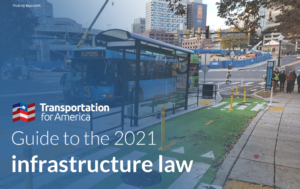USDOT controls $200+ billion in competitive grants for states and metros

While the bulk of the $643 billion for surface transportation in the infrastructure bill goes out to state DOTs, more than $200 billion stays with USDOT to be awarded via competitive grants to states, metro areas, and tribal governments—through dozens of newly created, updated, and existing competitive grant programs.
We’ve been following the money since the infrastructure bill passed back in November 2021, highlighting the most important things you need to know about the deal, actions the administration could take to accomplish their broader goals, some of the positives contained in the bill, and then precisely how much money there is for transportation in this unprecedented windfall.
In this post, we want to provide a brief high-level overview of how much competitive funding there is, why it matters that USDOT has some control over which projects get funding, and a few notable programs to pay attention to for various reasons—good and bad alike.
This post is part of T4America’s suite of materials explaining the 2021 $1.2 trillion Infrastructure Investment and Jobs Act (IIJA), which governs all federal transportation policy and funding through 2026. What do you need to know about the new infrastructure law? We know that federal transportation policy can be intimidating and confusing. Our hub for the new law will walk you through it, from the basics all the way to more complex details.
First, what are competitive grant programs, and why does it matter that USDOT has some control over them?
Unlike the much larger formula programs that dole out a fixed amount of money to states or metro areas based on factors like population and miles driven, projects are selected for funding by USDOT in competitive grant programs based on how they will perform in priority areas, and USDOT often has wide discretion for establishing those criteria. As one example, President Trump’s USDOT dramatically shifted the BUILD (formerly TIGER) program from more innovative, multimodal projects to one focused mostly on building and expanding roads. (This program still exists and is now called RAISE.)
For the Biden administration to fulfill their ambitious pledges to improve state of repair and safety, eliminate inequities, and reduce emissions from transportation that are fueling climate change, they will have to use every bit of discretion at their disposal within these competitive programs to ensure the projects they fund contribute to those priority goals.
A high level look at overall funding for the deal’s competitive grant programs
The infrastructure law contains funding for multiple competitive grant programs. Some are new to this bill, addressing emerging and poignant issues in transportation. Within these USDOT-administered programs, just north of $103 billion is set aside for the Federal Highway Administration, $30 billion is for the Federal Transit Administration, $59 billion is for the Federal Railroad Administration, and $6 billion is for the Federal Motor Carrier Safety Administration. This funding breakdown is notable because each modal administration operates within parallel but often different policy frameworks, which influences how the grant programs get administered.
To help you best utilize them, T4America has organized a high-level list of the various competitive grant programs by topic area. Two caveats: These many programs overlap in purpose, and many are created to move the needle in multiple areas. I.e., TIGER was a multimodal program, a freight program, a safety program, a bike/ped program—all squished into one. Also, this list is not exhaustive by any stretch, though we are producing a complete list like that for our T4America members to equip them to take advantage of the funding that best meets the challenges and context of their communities.
The lion’s share goes to multimodal grant programs
Approximately $116 billion of the $200 billion allocated to competitive grant programs is aimed towards planning for, advancing, building, and implementing multimodal connections in our communities. This broad category is typically highly competitive, considering that it typically funds notable but neglected local or regional priorities that elected officials love to cut the ribbons on. More specifically, this category includes:
$31.25 billion towards larger national, state, and local project assistance programs
- RAISE grants: $30 billion over five years for a competitive grant process towards roads, rail, transit, and port projects that help achieve national, state, and/or regional objectives. (For comparison’s sake the old TIGER/BUILD program it replaced invested only $4 billion since 2009.) As with the program it replaces, the criteria USDOT writes and how they administer the selection process will have an enormous impact on whether or not these projects advance the administration’s goals.
- TIFIA: $1.25 billion over five years to help finance large transportation projects with direct loans, loan guarantees, and credit risk assistance. It’s first-come, first-serve, though some make a compelling case we’d get far better projects if it was discretionary.
$27.5 billion in transit grants
- Capital Investment Grants: $23 billion over five years for expanding or building new transit,
- Bus and bus facilities grants: $2 billion over five years to procure, repair, and/or enhance buses as well as construct, enhance, and/or bring to a state of repair bus-related facilities, and
- Ferry grants: $2.5 billion over five years, of which $0.5 billion is for the procurement, repair, and/or enhancement of ferries to low to no emissions, and $2 billion is for rural essential ferry services.
$54 billion for rail-focused programs
- Consolidated Railroad Infrastructure Safety Improvement (CRISI) ($10 billion over 5 years), which focuses to improve the safety, efficiency, and reliability of intercity passenger and freight rail,
- The new Federal-State Partnership for Intercity Passenger Rail ($43.5 billion) which allows the expansion of or construction on new intercity passenger rail routes in addition to capital projects that address state-of-good repair, and
- Railroad Improvement Financing (RRIF) program ($600 million) which helps to finance railroad projects with direct loans, loan guarantees, and credit risk assistance.
However, there are a few programs in this broad category that are new but unfunded and therefore subject to annual appropriations. That includes the Active Transportation Infrastructure Investment Program, authorizing $1 billion towards active transportation networks in communities, as well as the Strengthening Mobility and Revolutionizing Transportation grant program, authorizing $1 billion towards piloting innovative technologies that improves safety and system operation efficiency.
Repair
Approximately $50 billion worth of competitive programs are aimed towards prioritizing the state of repair in our communities. The bulk of that (~$43 billion) is directed towards the new Bridge Investment Program, which is a program to repair, rehabilitate, replace or protect bridges that are in disrepair. (Not to be confused with funding for bridge repair flowing through a new formula program announced just this week.) There is also just shy of $2.5 billion directed towards transit state of good repair grants that targets heavy rail transit and a station retrofits program for compliance with the Americans with Disabilities Act. Additionally, $250 million is directed towards rail Restoration and Enhancement grants for passenger rail infrastructure repair.
While it’s laudable for the infrastructure law to have discretionary grant programs dedicated to various aspects of the state of transportation repair, the fact that repair priorities are not central to the much larger, massive state-controlled formula programs (other than a strong encouragement memo from FHWA) leaves much to be desired.
Safety
Approximately $12 billion of the competitive grant programs are predominantly aimed towards prioritizing safety. Of that money, $6 billion is focused on the new Safe Streets and Roads for All grant program. That notable new program focuses on improving street safety and reorienting it towards people focus and is exclusively intended for non-state government entities (think counties, cities, towns, tribal communities, regional organizations like MPOs). Additionally, $5 billion in grant funding is focused on eliminating rail crossings.
However, there’s also a clear, stated emphasis on improving safety woven through the majority of many competitive grant programs—including big ticket programs like RAISE—so the administration has a real opportunity to make safety a tangible priority in how they stand up the projects and run the selection processes.
Climate and environmental mitigation
Approximately $15 billion of the competitive grant programs are aimed towards making an impact on climate change and the environment, thought the biggest single pot under this umbrella is for electrifying the transportation system (i.e, electric cars and trucks), which is a high priority for Biden’s USDOT, which is already seeking implementation guidance. Within this category, there is:
- $7.5 billion aimed towards electrification of our transportation system (focused extensively but not exclusively on cars and roads).
- Complementary to a related $7.3 billion formula grant program, the new $1.4 billion PROTECT competitive grant program has tiered layers of funding opportunities focused on planning, capacity building, and targeted climate mitigation and/or resiliency infrastructure funding.
- $5 billion is set aside for culvert restoration, removal, or replacement, so as to reduce the impact on wetland environments and fishery.
- $400 million in grants are aimed to curb freight emissions at ports.
- $500 million authorized (but unfunded) for Healthy Streets, which looks at streetscape treatments to reduce the urban heat island effect in communities.
Equity
One of the most exciting additions in the infrastructure bill is the $1 billion for the new Reconnecting Communities program focused on tearing down or bridging transportation infrastructure that divides communities and promoting community connections that are people- versus vehicle-focused. The program is notable in working to redress the socioeconomic damage to marginalized communities, though the funding in the infrastructure law is only seed money towards a significant need in the US. Additionally, the Healthy Streets program, noted above, would bring numerous environmental benefits, and could be deployed to target the urban heat island effects that disproportionately impact marginalized communities.
Rural needs
While there is $3.25 billion set aside for rural surface transportation grants, T4America is disappointed that $1.5 billion of that is aimed at just building more highways in Appalachia, as if highways were the sole cure to all rural transportation needs. Rural America desperately deserves a more complete vision for transportation. (We have some ideas.)
Positioning for competitive grant application success
With about five dozen competitive, surface transportation grant programs to administer, USDOT faces a heavy lift to get these programs off the ground, on top of administering the legacy programs that already existed. However, that doesn’t mean communities can’t start to position themselves for success. There’s opportunity to think about not only what projects to pursue, but also contemplate identifying and leveraging supplemental funding sources.





















1 Comment